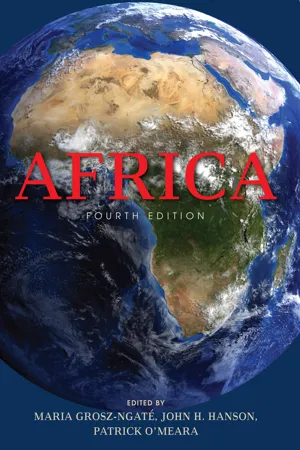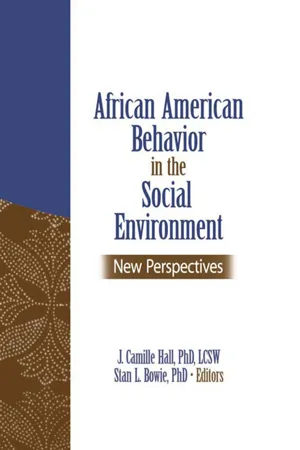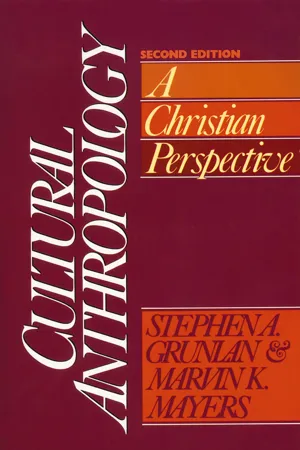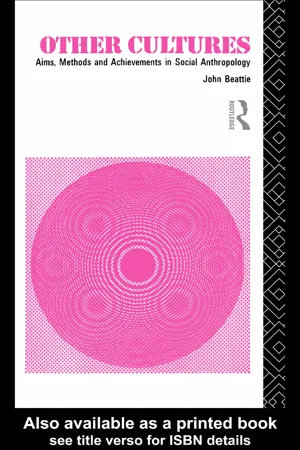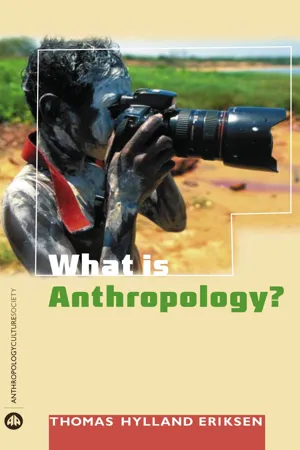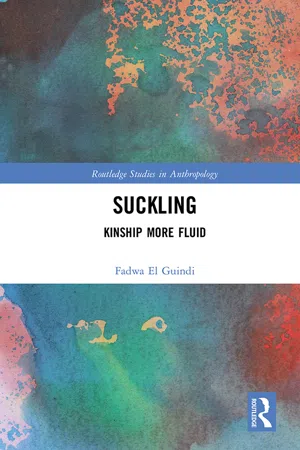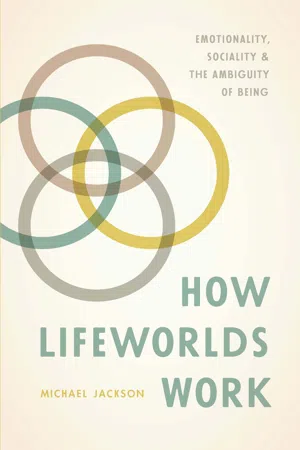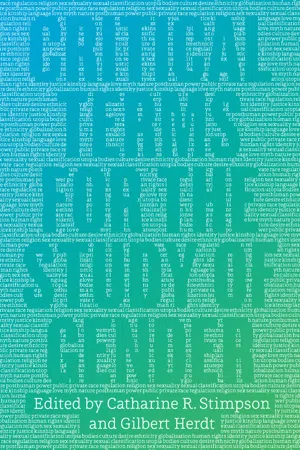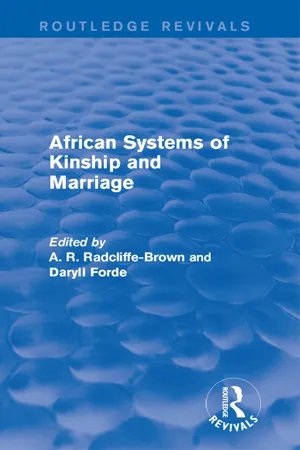History
Kinship in Africa
Kinship in Africa refers to the complex system of social relationships and connections based on blood ties, marriage, and adoption. It plays a crucial role in African societies, shaping social organization, inheritance, and political structures. Kinship also influences economic activities, religious practices, and the transmission of cultural traditions across generations.
Written by Perlego with AI-assistance
Related key terms
Related key terms
1 of 4
Related key terms
1 of 3
11 Key excerpts on "Kinship in Africa"
- eBook - ePub
- Maria Grosz-Ngaté, John H. Hanson, Patrick O'Meara(Authors)
- 2014(Publication Date)
- Indiana University Press(Publisher)
News accounts of violent conflict in Africa frequently make reference to “tribe” and “tribalism” as potent ingredients of discord. The use of “tribe” in the African context is a legacy of colonialism and the research of early anthropologists. Anthropologists wanted to know how African societies without centralized leadership maintained order and stability while colonial officials demarcated African societies for the purpose of rule, ignoring complexities, interactions between groups, and the fluidity of boundaries. The persistent characterization of African populations as “tribes” gives the appearance of timelessness and glosses over the different forms of political organization that existed in the past. It implicitly suggests that tribe (or ethnic group) is the primary source of identity and mode of sociopolitical organization on the continent. It also obscures the existence of more important forms of identification, relatedness, and belonging that may play a role in, counteract, or facilitate the resolution of conflict. Like people in other parts of the world, Africans are enmeshed in a range of institutions and identify with multiple collectivities. An individual may be a mother, wife, sister, and daughter; a cultivator, cloth dyer, or teacher; a member of an age group, a participant in a local or national women’s association, and a member of an ethnic group as well as a citizen of a nation-state. These social positions and identities overlap and cross-cut each other; which of them takes precedence at any given time depends on the context.This chapter focuses on social relations as lived and constructed through kinship, marriage, and forms of association beyond the family. It illuminates the diverse ways in which individuals negotiate these institutions and the changes taking place as a result of the day-to-day actions of African women and men in the context of historical, political, and economic processes that impinge on their lives. Social relations are dynamic and change is not new; yet transformations are often subtle before they become visible or acknowledged as a result of an event that brings them to the fore. Africans may highlight continuity when asked about specific practices. At the same time, older people contending that young people act very differently than they themselves once did often ignore the variability that already existed during their own youth.FORMS AND MEANINGS OF KINSHIP
Drawing on Western models of economic transition, twentieth-century modernization theorists assumed that the importance of kinship bonds would diminish once African economies developed and state institutions created a social safety net. Yet kinship has not lost its salience as a moral order that structures relationships and guides people’s actions as they meet the challenges of contemporary life. Anthropologists have used the concept of “kinship” to understand who gets counted as “family” in different African societies.1 - eBook - ePub
African American Behavior in the Social Environment
New Perspectives
- J. Camille Hall, Stan L. Bowie(Authors)
- 2013(Publication Date)
- Routledge(Publisher)
KINSHIP AND SOCIAL SUPPORT RESEARCHPassage contains an image
Who Is Kin? Family Definition and African American Families
Pearl Stewart
SUMMARY. This article explores the ways in which African Americans, define family and kinship. Using data collected using ethnographic methods, issues such as the level of ongoing commitment to extended family structures, fictive kin status and obligations and pathways to kinship status are examined. This study has broad implications for the delivery of culturally appropriate services to African American individuals and families. doi:10.1300/J137vl5n02_10 [Article copies available for a fee from The Haworth Document Delivery Service: I-8OO-HAWORTH. E-mail address : <[email protected] > Website: <http://www.HaworthPress.com > © 2007 by The Haworth Press, Inc. All rights resented.]KEYWORDS. African American families, kinship, family definition, extended family, ethnographic researchINTRODUCTION
One of the key issues with respect to doing effective work with families and children is the need to develop definitions of family and kinship that are culturally and socially appropriate. These definitions have many implications for the provision of services and for the development of the policies that guide those services. For African Americans, identification with a kin group is “a major aspect of identity from birth” (Clark-Lewis, 1994, p. 24). Individuals are identified with their families and their behavior is a reflection on those families.Historically, African Americans have held a view of family and kinship that focused on extended rather than nuclear relationships. The emphasis on extended family groups originated in the West Africa communities from which slaves were taken, was maintained throughout the eras of slavery and emancipation, and has contributed to the resilience of African American families (Hill, 1998; Littlejohn-Blake & Darling, 1993). In the harshness of the Post-Emancipation South, it was kin that met the need for moral and economic support on a daily basis and in times of crisis. Since African American families in the South, especially those in rural environments, had little or no access to governmental supports, it was the families that pooled resources to provide care for their members throughout the life span (Scannapieco & Jackson, 1996). - eBook - ePub
- Stephen A. Grunlan, Marvin K. Mayers(Authors)
- 2016(Publication Date)
- Zondervan Academic(Publisher)
Kinship is more than a network of biological relationships; it is also a network of social relationships. It establishes social ties, patterns of behavior, obligations and responsibilities, and patterns of authority. In short, it is a “road map” or structure of interpersonal relationships.Among the aborigines of Australia, when two strangers meet they do not greet each other until they have determined how they are related so that the proper greeting may be used. If they determine they are not related, they try to kill each other. As might be expected, the aborigines practice exogamy to expand their kinship network.Kinship relationships are the basis of the social structure in most nonwestern societies. This is true not only in small villages but also among large tribes. The Nuer of the Sudan in Africa number over one hundred thousand. Yet, they have no political or legal authority structure. There is no king, chief, or ruling council. Nevertheless there is social order, economic development, and organized defense. The Nuer social structure is based on a kinship system. The society functions by the obligations and responsibilities of kinship. How can a society this large maintain social order without a political or legal authority system? Does a North American mother call the police to make her son take a bath? No; yet he takes a bath. In the same way the Nuer family has the power and the responsibility to control its members. - eBook - ePub
Other Cultures
Aims, Methods and Achievements in Social Anthropology
- John H.M. Beattie(Author)
- 2005(Publication Date)
- Routledge(Publisher)
PART TWOPassage contains an image 7 Kinship (1)
ACCORDING TO THE DICTIONARY, kinship has to do with relationships by blood, or consanguinity; affinity with relationships brought about by marriage. In social anthropology the two topics are very closely connected. All cultures distinguish various categories of kin and affines, and these categories, with their associated patterns of rights and obligations, make up what social anthropologists call kinship systems. In some societies every individual is, or thinks he is, related by kinship or affinity to everyone else: in others, including most Western ones, a man’s kin and affines are limited for practical purposes to a few close relatives. But in every society some relationships of kinship and affinity are culturally recognized.In this chapter I discuss the kinds of interest which social anthropologists have taken in kinship: in the next I consider marriage and affinity. Social anthropologists are sometimes accused of concerning themselves overmuch with the refinements and complexities of kinship terminologies, of indulging in what Malinowski called ‘kinship algebra’. But there are good reasons for this concern. Very few of the interpersonal relationships which make up a Western European’s social world are kinship ones. Kinship plays little or no part in his relations with his friends, his employers, his teachers, his colleagues, or in the complex network of political, economic and religious associations in which he is involved. But in many smaller-scale societies kinship’s social importance is paramount. Where a person lives, his group and community membership, whom he should obey and by whom be obeyed, who are his friends and who his enemies, whom he may and may not marry, from whom he may hope to inherit and to whom pass on his own status and property—all these matters and many more may be determined by his status in a kinship system. Where everybody is or thinks of himself as being related to nearly everybody else, almost all social relationships must be kinship or affinal ones too. But even where kinship is less pervasive, it usually plays a much more important part than it does in modern urban and industrialized Western societies. - eBook - ePub
Social Change in Modern Africa
Studies Presented and Discussed at the First International African Seminar, Makerere College, Kampala, January 1959
- Aidan Southall(Author)
- 2018(Publication Date)
- Routledge(Publisher)
The reason why kinship obligations can be more easily evaded in town is not merely the frequently high mobility, as a result of which particular kin are constantly disappearing from the urban scene, but the restriction in the scope of kinship already noted. The significance of kinship in the economic field becomes slight because, although relatives help one another to find jobs, it is rare to find brothers or other close kin working as servants in the same house, in a factory at the same bench, or in a mine at the same rock face. But even if they did, they would be working within a system regulated by persons unaware of their kinship and by rules which deny its relevance. The solidarity which obtains where relatives must rely on one another for the production of their food is absent. In the political field, too, kinship loses much of its relevance. In tribal systems, the extent to which political roles are subsumed in or linked to those of kinship varies greatly, but is always more than is usual in town. Although kinsmen in town rely on one another for some degree of mutual aid and security where possible, African urban populations are bound to recognize the predominant part played in its maintenance of order by the interlocking network of large-scale economic and political institutions, including those of local government and the police, even where these are not conceded full legitimacy by them. It is only in some of the West African towns that Africans are found in charge of the main institutions of law and order. But many innovations are occurring in this field, as in the appointment of African burgomasters in the Congo and the appointment of the first African Mayor of Kampala. Where African townsfolk have organized spontaneously for political ends it is the concept of tribe rather than kinship which provides the only traditional integrating factor.It is the domestic field which still provides the main scope for kinship in town. This too is limited where single men form a large element in the population and where irregular unions are a frequent substitute for traditional marriages. The extrinsic factors of urban administration and housing policy exert strong influence here. Where most housing is officially provided, movement to town restricted and independent employment rare, there are usually large numbers of single men, frequent irregular unions, and the more stable families are restricted to the nuclear type. Where movement into town is unrestricted, housing built by African private enterprise and independent employment frequent, the situation is altogether more favourable to family life and even extended families and larger groups of kin may be found. Salisbury, Gwelo, the Copperbelt, Katanga, Nairobi, Mombasa, and most plantations are obvious examples of the first situation: Dar-es-Salaam, Kampala, Blantyre, Leopoldville, Brazzaville, Douala, Lagos, and most West African towns of the second. It corresponds to the distinction between towns of type A and type B. - eBook - ePub
- Thomas Hylland Eriksen(Author)
- 2004(Publication Date)
- Pluto Press(Publisher)
primary relationships is often used to describe the closest and most enduring ties between persons. Many relationships of this kind are based on the overlapping institutions of kinship, family and household, but local communities and work relations can also provide a person with a strong and long-lived sense of personal belonging. There are, naturally, also other ways of organising primary relations; religious and political groups may play an important part, and some would also claim that the ‘imagined community’ of the nation can be a well-functioning surrogate for kin or family. In this chapter, which might have been called ‘Social organisation’ rather than ‘Kinship’, it would have been perfectly possible to write about the local community, the village or the household as a basic unit. The fact that the entire chapter is instead devoted to kinship, is due to a conviction that kinship lies at the base of the most viable forms of social organisation. This is certainly not always the case in a literal sense; kinship can often be extremely effective as a metaphor, and it is not true, as some overzealous adherents of biological explanations argue, that human acts can be explained with direct reference to their biological nature. Yet, it may be stated unequivocally that kinship and family are extremely basic, probably universal ways of thinking about, and organising, human belonging.KINSHIP STUDIESThe last sentence may, at a glance, seem prosaic and pedestrian, bordering on the trivial. It is therefore not irrelevant to point out that such a statement is profoundly controversial in contemporary anthropology. Many anthropologists are on the verge of abandoning the concept entirely because, they argue, it does not travel well, that is to say it has no cross-culturally valid meaning. The concept of kinship as it has been used in anthropology since Morgan and Tylor, they argue, is ethnocentric and biologistic; it builds upon specific western ideas about kinship, and it is also based on notions about biological relatedness which dominate western society but not necessarily elsewhere. Although this critical attitude is necessary, evidence has not supported it well; a century of meticulous ethnographic research has shown that most peoples have similar (but far from identical) ways of thinking about kinship and blood relations.In a review of the state of the art in kinship studies, Ladislav Holy (1996) commented some years ago that kinship was for many years a domain which anthropology could rightfully claim as its own. No other discipline in the social sciences or humanities studied kinship systematically. Among sociologists and psychologists there might be many who were interested in the family, but they covered only a tiny patch of the subject matter proper of anthropological studies of kinship. In the early 1950s, in the heyday of British structural-functionalism, kinship studies were in fact so dominant that outsiders spoke ironically of the subject as kinshipology. - eBook - ePub
Suckling
Kinship More Fluid
- Fadwa El Guindi(Author)
- 2020(Publication Date)
- Routledge(Publisher)
The iconic rhetorical question by Gregory Bateson is relevant here: “What pattern connects the crab to the lobster and the orchid to the primrose and all the four of them to me?” (Bateson 1979: 8). It is demonstrated in this work as in my earlier publications on the subject how kinship is a highly structured universal human phenomenon. For social relations to be identified as “kinship” they would have social organizational features such as a culturally shared classification of relatives, with assigned kin terms (a special kin terminology), identifying reciprocal responsibility which extend vertically and horizontally necessarily beyond dyads.It was Henry S. Maine in 1939 (Maine 1931[1861] (reprinted in 1959)) who clearly stated that the family, in fact, was a “corporation” (11) and that “corporations never die” (12). “The decease of individual members makes no difference to the collective existence of the aggregate body”. I repeat this characterization and confirm it after analysis of recent field data on non-primitive Arabian kinship (Maine 1931[1861]).To be considered kin individuals corporately share the responsibility of building and the obligation of protecting a shared reputation, a shared honor, shared estate, throughout their lifetime and after the death of individuals (El Guindi 2003[1999]). The feature of cementing community relations through birth and marriage and ties among populations through exchange goes back in anthropology as early as Edward B. Tylor (Tylor 1889) who wrote how “by binding together a whole community with ties of kinship and affinity … it tends to keep down feuds and to heal them when they arise – exogamy – cementing populations into nations capable of living and holding together” (29). Relations would be bound by formal rules of avoidance and extended prohibitions. Leaving out the factor of violence,2 - eBook - ePub
How Lifeworlds Work
Emotionality, Sociality, and the Ambiguity of Being
- Michael Jackson(Author)
- 2017(Publication Date)
- University of Chicago Press(Publisher)
PART 2Kinship organization is as much a matter of feeling as it is of thinking, or, to use more scholarly words . . . kinship is as much a matter of “affect” and free form “aesthetics” as it is a matter of “cognition” and social “regulation.”«MARGARET TRAWICK , Notes on Love in a Tamil Family (1990)»Discussion of emotion has long been absent from Africanist scholarship on intimate relations.«JENNIFER COLE and LYNN M. THOMAS , eds., Love in Africa (2009)»The Dynamics of Kinship
If rites of passage are characterized by an intensification of affect—of increased anxiety and dramatic enactments of emotional states—the field of kinship is even more so. Nowhere else is the tension between the maintenance of control and the passions of love and hate so keenly felt and so difficult to manage. Despite anthropological idealizations of kinship as “mutuality of being” or “intersubjective belonging,”1 based on “the axiom of amity,”2 psychologists and ethologists have repeatedly observed that attachment is characterized by deep ambivalence. Indeed, the more intimate and intense the bond, the greater the potential for dissatisfaction, schism, and antagonism. It may be true that “kinsmen are people who live each other’s lives and die each other’s deaths,”3 - eBook - ePub
- Catharine R. Stimpson, Gilbert Herdt, Catharine R. Stimpson, Gilbert Herdt(Authors)
- 2014(Publication Date)
- University of Chicago Press(Publisher)
9 : : KINSHIP JANET CARSTEN The Oxford Dictionary of English Etymology entry for “kin” begins “family, race; class, kind,” and goes on to list words that share kin ’s Indo-European base: agnate, cognate; benign, malign; nation, nature; genus, general; generate; generous; degenerate, regenerate; genius, ingenious; ingenuous, ingenue; indigenous; kind; progeny; -gen, gono-; gentile; genital, genitive, germ, germinate, germane. (Onions 1966, 505) Nation and nature; generous and malign; gentile and germ—all derive from the same root. It takes little reflection to see that they are all potentially part of our experience of being kin. Yet the study of kinship has often seemed to rest on peculiarly narrow assumptions about what kinship is. These assumptions have in turn inspired some exceptionally dry and abstruse academic debates between proponents of rival theories of kinship, debates that have touched on issues of gender in a number of striking ways. The knotty relation between kinship and gender makes the omission of “gender” from the ODEE list seem less odd than it might appear, although the dictionary does mention that the sense “gender, sex” was present in Old English and early Middle English. From the beginning of the twentieth century, the comparative study of kinship within the social sciences became the specialty of the emerging discipline of social or cultural anthropology. Anthropologists made the description and analysis of local kinship systems (whether in Africa, Polynesia, Melanesia, or Asia) central to their studies. Conversely, until the last quarter of the twentieth century, scholars who wished to make a mark in the discipline were more or less expected to include kinship as a central part of their ethnographic work. While kinship became the locus classicus of anthropological scholarship, what was meant by “kinship” was itself an artifact of a particular set of academic assumptions that—implicitly at least—had gender at their core - eBook - ePub
Doing Anthropology
A Guide By and For Students and Their Professors
- Simone Dennis, Andrew Dawson(Authors)
- 2022(Publication Date)
- Routledge(Publisher)
5 Kinship and relatednessDOI: 10.4324/9781003273547-5Some orienting notes to get you started
In this chapter, we’re going to have a look at why was kinship so important to the discipline early in its history. That will get us right into the thick of thinking about how anthropologists working in the colonial period (and for a long while afterwards) made sense of ‘other’ people’s cultures – precisely by looking at their kinship arrangements. This legacy is a bit more enduring than you might think. We’ll consider the lingering consequences that these anthropologists – especially the structural functionalists – left behind, and why the kind of thinking that they did worked so well at the time (and why it doesn’t now). We’ll think about what’s happened since then, and what it means to look at kinship arrangements now. But most importantly of all, we want this chapter to prompt you to think creatively about what you can find out using genealogical methods. Simone especially loves using this method to think about how smokers make smoking safe for themselves, and how families can be understood in and through the relations of touch. You need imagination more than you need a complete technical mastery to make genealogical methods animate how people are connected, so have a crack at it and see how yours works to think about relatedness.Studying kinship entails realising that different people have different ways of making sense of their relationships, and operationalising them. Perhaps the ways of organising kinship with which you’re most familiar aren’t the most common ways of being organised. Some of the ways of being related we’ll tell you about in this chapter will seem really alien to you. Some will feel familiar. Just remember to come back to a position of making uncommon sense, and make sure you do that with your own presumptions about relatedness. It might seem to you that calling one person ‘Father’ is universal. No! Your positions are familiar to you, but if you remember that everyone else feels that way about their positions, you might be less prone to make presumptions. That’s important for really understanding relatedness from the perspectives of people besides yourself. - eBook - ePub
- A. R. Radcliffe-Brown, Daryll Forde(Authors)
- 2015(Publication Date)
- Routledge(Publisher)
Likewise, an affine is conyimar, husband of sister, conyal, husband of daughter, or of some other affinal category, and is addressed as gwa, father, demar, my brother, or gatda, my son, as the case may be. Lineages are articulated as groups of agnatic kin at a different situational, usually ritual, level of the social life and are articulated as conglomerates fused with other elements at yet a different situational, the political, level. Kinship ties belong to another order of social relations, relations between persons and not between groups. The members of a lineage group are socially undifferentiated as such in the interlineage structure because it is a structural relationship between groups. In the kinship system they are socially differentiated—this being an essential characteristic of the system—because the kinship system is a system of relationships between persons. As we have seen, members of a Nuer community are all mar, kin, to one another. Whoever is kith must also be kin. Common membership of a village or camp does not in itself provide a man with a secure basis for his personal relations with its other members. That is provided chiefly by the kinship system by which a kinship tie established with any person in the village or camp gives a man a kinship status of some kind with every other person in the village or camp, with all his neighbours. A village or camp is a community of kin. This means that from the point of view of any of its members the other members are his kindred (including affines in this term) and also that he knows, at any rate more or less, in what way any one of them is related to a third person. It does not, however, mean that together they constitute a specific kinship group
Index pages curate the most relevant extracts from our library of academic textbooks. They’ve been created using an in-house natural language model (NLM), each adding context and meaning to key research topics.
Explore more topic indexes
Explore more topic indexes
1 of 6
Explore more topic indexes
1 of 4
